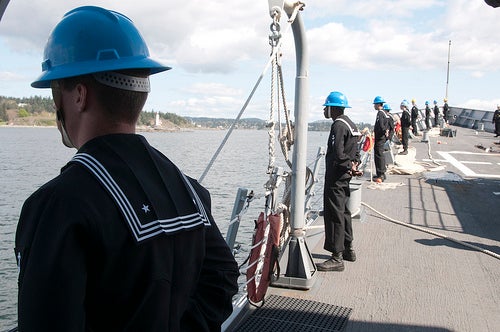
US and Canadian armed forces have concluded a biennial joint naval exercise, codenamed Trident Fury 2013, aimed at enhancing communication and coordination capabilities between coalition forces.
Led by the Royal Canadian Navy, the exercise involved more than 1,100 personnel from the Royal Canadian Navy, the Royal Canadian Air Force, the Canadian Army, the US Navy, the US Air Force, the US Air National Guard, and US Coastguard (USCG).
During the exercise, sailors performed various bilateral evaluations, including anti-submarine warfare, war-at-sea exercises, daily multi-ship manoeuvring, gunnery exercises on a moving target, helicopter exercises and small boat exercises.
USS Ford (FFG 54) command senior chief (SW/AW) Joe Lovelace said: "We really got some valuable training for the crew that they will be able to use for future operations."
Canadian naval assets, including Iroquois-class destroyer HMCS Algonquin (DDG 283), Halifax-class frigate HMCS Ottawa (FFH 341), Kingston-class coastal defence vessels HMCS Nanaimo (MM 702), HMCS Saskatoon (MM 709) and HMCS Edmonton (MM 703), as well as Victoria-class submarine, HMCS Victoria (SSK 876), participated in the exercise.
In addition, the exercise involved US Navy Lewis and Clark-class dry cargo ship USNS Carl Brashear (T-AKE-7), Oliver Hazard Perry-class frigate USS Ford (FFG-54), Ticonderoga-class cruiser USS Lake Champlain (CG-57), Arleigh Burke-class guided missile destroyer USS Spruance (DDG-111) and USCG cutters Rush and Orcas.
Lockheed Martin-built CP-140 Aurora and CC-130J Hercules, Sikorsky CH-124 Sea King, McDonnell Douglas-designed CF-18 Hornet and F-15 Eagle, Dassault/Dornier Alpha Jets, as well as Northrop Grumman EA-6B Prowler and EA-18G Growler aircraft from the two nations also participated in the drills.
Trident Fury drill aims to enhance relationship between the maritime and aviation forces of the US and Canada as well as to boost the US Navy’s ability to respond to crises and protect the collective maritime interests.
Image: Sailors aboard the USS Ford during Trident Fury 2013 exercise. Photo: courtesy of US Navy, by mass communication specialist seaman apprentice William Blees / Released.





